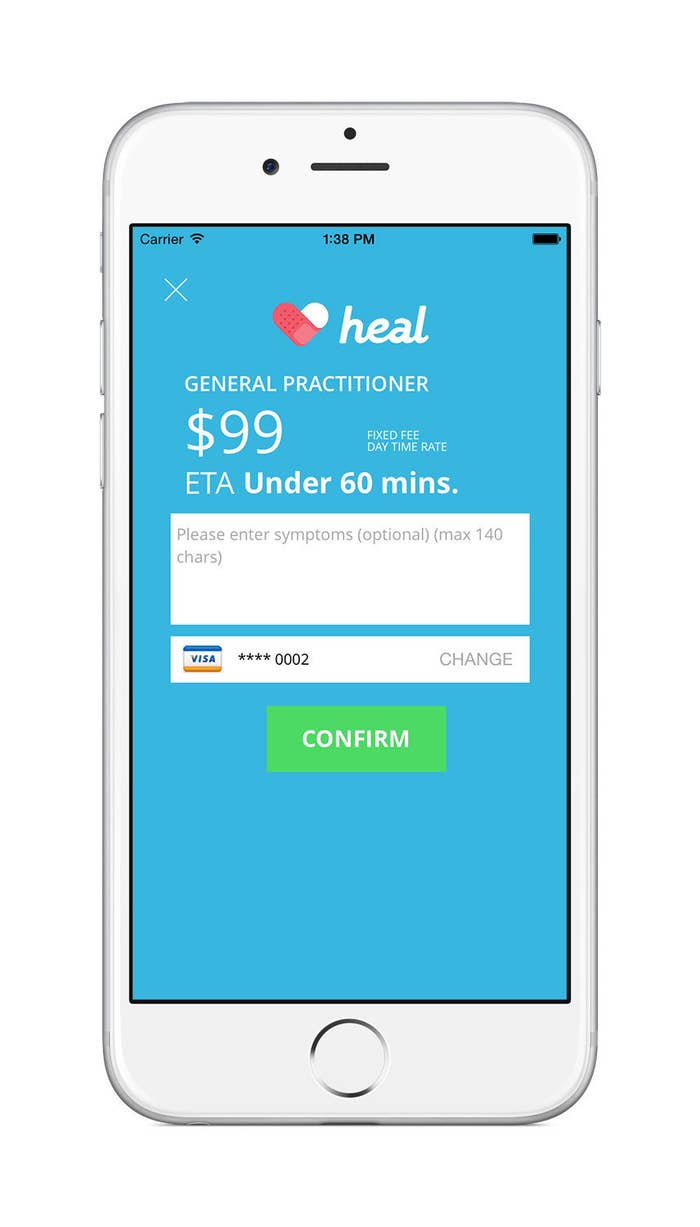
Starting today, Heal is attempting to change the way San Franciscans think about primary health care. Launched in Los Angeles in February, the on-demand health care company could help parents with feverish kids or working professionals with runny noses summon qualified doctors at the tap of a button (or, soon, the swipe of an Apple Watch), for $99.
Though Heal's doctors can't, for obvious reasons, perform complex procedures, diagnose serious conditions, or do much of anything that requires sophisticated equipment, they can take on the kind of relatively small-scale complaints that bring many people into their primary care doctors' offices — and thereby help people avoid spending the better part of a workday driving to and waiting in the doctor's office in order to get a quick question answered or a medication prescribed.
Heal was founded by Dr. Renee Dua, a practicing nephrologist, and her husband, Nick Desai, an entrepreneur; the idea came out of the couple's frustration with trying to balance their busy schedules with finding a doctor for their small child. But it also comes from Dua and Desai's understanding of how inefficiencies in the health care system can, in practice, degrade the patient's care, from the firsthand experience of a doctor. "You can't fix medicine for patients if you don't fix it for doctors," Desai told BuzzFeed News.
Janani Krishnaswami, a doctor who's been with Heal part-time since before it launched in L.A., agrees. Given her interest in technology, frustrations with the health care system, interest in preventative medicine, and the flexible schedule, she said joining Heal was a "no-brainer." But she also thinks it's better for patients.
"It's very rare for someone to feel comfortable in a medical setting," said Krishnaswami. "You're surrounded by people who are suffering, there's an exam table, you feel exposed. It's hard to get at the root causes — the lifestyle factors — that are causing the same patterns. I would see these patterns in my patients, and I felt frustrated that I wasn't really able to work with them as an advocate."
Heal wouldn't say how many users in L.A. have downloaded its app, or how many visits its team of around 40 doctors has made so far. Dua and Desai did say that over 30% of those who requested a doctor on Heal became repeat users, which makes sense — if you're already the kind of person comfortable summoning a professional you've never met to your home and paying $99 up front for their services, as long as the first try isn't a disaster, why wouldn't you do it again?
It's worth noting that Heal isn't the first startup to try to find a way to use technology to to streamline basic medical care. Many of them — including Dr. Phil's Doctor on Demand — replace the in-office visit with video conferencing. Others, however — such as Medicast and Pager — are very similar to Heal, in that they offer house calls from real live physicians.
There are a few things that set Heal apart, but a big one is the price point. Though a visit from Heal costs more than a visit to a clinic by an average of around $30–40 — not an insignificant sum for many families — Desai says investors tend to ask how the cost is so low, not why it's so expensive. (Those investors include, but are not limited to, Qualcomm Chair Paul Jacobs, Lionel Ritchie, March Capital, and former L.A. Dodgers co-owner Jamie McCourt. The company has raised $1.5 million in seed funding. )
Soon, Heal doctors should be able to do some basic tests, such as urine samples and saliva swabs, in home. Patients will also soon have the ability to request repeat visits from a doctor and to stay in touch with their physician by phone. For a $19 fee, medical assistants will make pharmacy visits, picking up not only prescriptions but other things that sick people need, such as tissues, painkillers, or, said Desai, ramen noodles.
Heal is also working on a collaboration with insurance providers that would only require a co-pay and a service fee from users, rather than the $99 flat rate. But for now, if you want to see a doctor, you need to have a hundred bucks in your bank account and hope your insurance provider reimburses you. So while people with disposable income might find Heal useful, those without will be might be left in the waiting room.
When the on-demand labor industry was in its nascency, mobile technology was used to call upon people who could do basic tasks, such as drive a car or pick up a package. Gradually, tech companies began pushing the concept further into skilled sectors, such as hairdressing and home repair. With the proliferation of apps like Heal, the gig economy pushes into the final frontier: white-collar workers. If you can get a doctor on demand, why not a tax attorney or a therapist? Enough people have become comfortable with the idea of using their mobile phones to hire people to do menial tasks that they're also, increasingly, willing to hire them to do more complicated things — which could bring a lot more jobs and a lot more money to this sector.
"If I can hit a button and get someone to bring me a pie, or give me a massage, or measure me and make my shirts," said Desai, "I should be able to get a doctor to my house."

